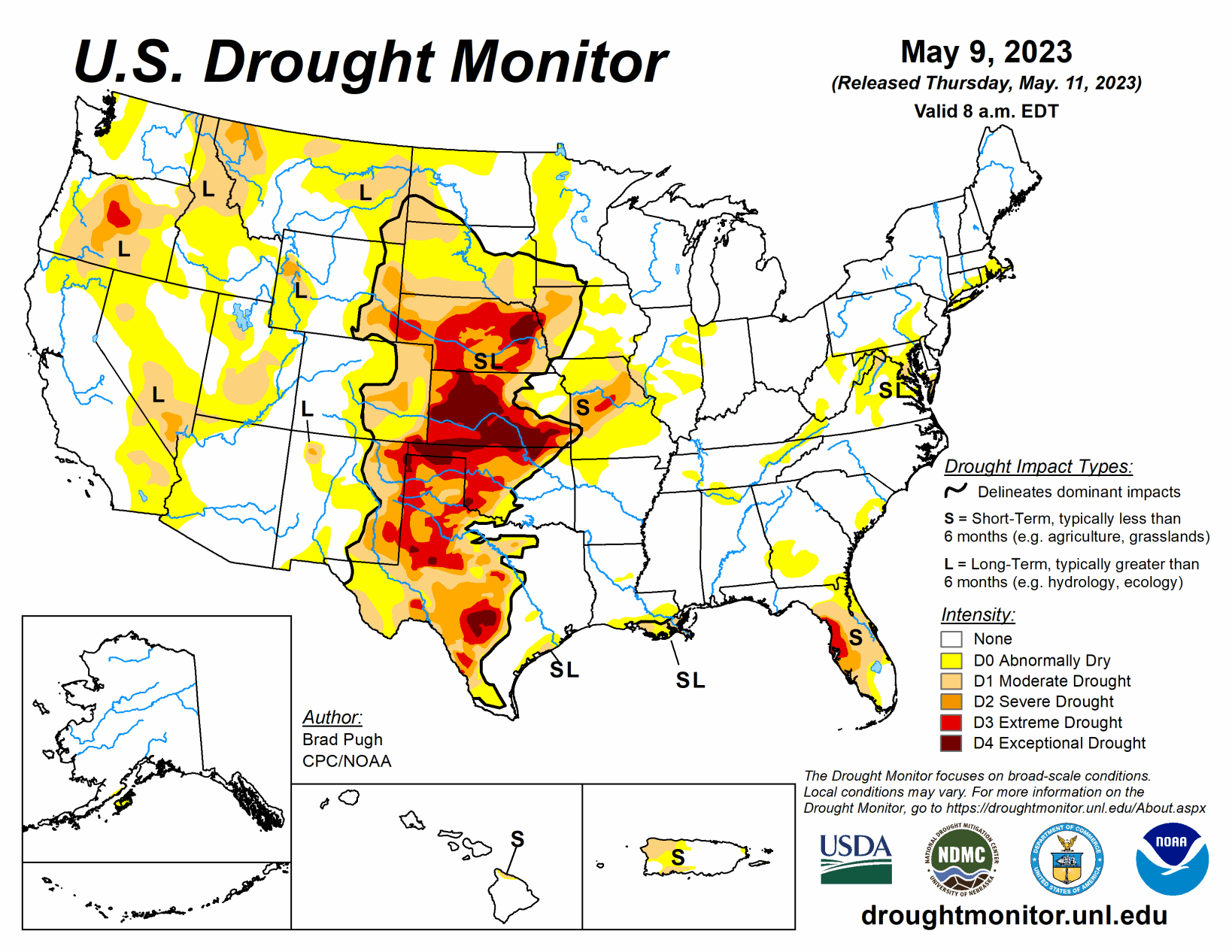Pockets of rain have helped some Plains states

A strong area of mid-level low pressure, near the West Coast, resulted in anomalously wet weather during the first week of May throughout the Pacific Northwest, Northern Rockies, Great Basin, and California.
Scattered thunderstorms brought pockets of heavy rainfall (more than 2 inches), from May 2 to 8, to parts of Texas, central Nebraska, and the Midwest. However, much of Kansas, Missouri, and southern Nebraska missed out on this beneficial rainfall. Following a wet end to April across the East, drier weather prevailed this past week from the Mid-Atlantic south to Florida. Seven-day temperatures, ending on May 8, averaged below-normal across most of the East along with California, the Great Basin, and Desert Southwest. Weekly temperatures averaged above-normal across the Great Plains.
A mix of degradations and improvements were made this past week to the Southern Great Plains, western Gulf Coast, Lower Mississippi Valley, and Tennessee Valley. Severe drought (D2) was slightly expanded in southeast New Mexico, based on 90-day SPI and USGS 28-day average streamflows falling below the 10th percentile along parts of the Black River. Based on declining soil moisture indicators, extreme drought (D3) was expanded westward across the Edwards Plateau.
More than 1.5 inches of rainfall this past week resulted in a 1-category improvement to parts of central and northwest Texas, the Texas Panhandle, and central Oklahoma. According to NDMC’s long-term objective drought blend, there remains a sharp gradient between extreme to exceptional drought (D3-D4) in northwest Oklahoma to anomalously wet conditions in southeast Oklahoma.
An increase in abnormal dryness (D0) was warranted for parts of northwest Arkansas based on increasing 30-day precipitation deficits and 28-day average streamflows below the 30th percentile.
A rapid expansion and intensification of short-term drought is ongoing throughout Missouri with much of the central and northern parts of the state receiving less than two inches of precipitation during the past 60 days when seasonal temperatures begin to warm. Based on 30 to 60-day SPI, NDMC’s short-term objective drought blend, and CPC soil moisture, a 1-category degradation was made to a majority of Missouri.
The addition of extreme short-term drought (D3) to central Missouri was supported by 60-day SPI, CPC soil moisture, USGS 28-day average streamflow below the 5th percentile, and NDMC’s short-term drought blend. Locally heavy rainfall (1.5 to 2 inches, or more) in parts of southwest and northern Missouri resulted in no change from the previous week or small improvements. Farther to the north across central to southeastern Iowa, heavy rainfall (1.5 inches or more) led to a decrease in abnormal dryness (D0).
The exceptional drought (D4) was removed from the southwest corner of Iowa due the lack of support from long-term indicators. D0 was reduced across parts of Illinois and adjacent Indiana where rainfall amounts exceeded 1.5 inches this past week. A slight D0 expansion was necessary near Lake Michigan where less than 0.5 inch of rainfall was observed. Based on improving long-term indicators, D0 was reduced across northern Minnesota. Increasing short-term precipitation deficits led to a slight expansion of moderate drought (D1) for southwestern Minnesota.
Convective rainfall, typical for early May, occurred this past week across parts of Kansas and Nebraska. In areas such as central Nebraska, that received more than 2 inches of rainfall and there was a lack of support from SPI at various time scales and NDMC’s objective drought blends, a 1-category improvement was made.
However, in areas that missed out on this rainfall, a 1-category degradation was necessary for parts of southern Nebraska and central to eastern Kansas. According to the U.S. Department of Agriculture, 64 and 68% of the pastures and ranges for Kansas and Nebraska, respectively, are rated poor to very poor. Abnormal dryness (D0) was expanded westward near and along the Colorado Rockies based on SPIs at various time scales, while an increase in severe drought (D2) coverage was justified for parts of the High Plains of eastern Colorado that missed out on the recent heavier precipitation. Based on multiple indicators including Condition Monitoring Observer Reports, abnormal dryness (D0) was reduced across northern parts of North Dakota.
Based on 60-day SPI and longer time scales, moderate drought (D1) was reduced in coverage across southwestern Wyoming. D1 was changed to long-term abnormal dryness (D0) in northeast Montana based on SPI at multiple time scales and a favorable soil moisture response this spring down to 20 inches. Severe drought (D2) was removed from central Utah due to a lack of support from long-term indicators.
Looking ahead
During the next five days (May 11 – 15, 2023), widespread moderate to heavy rainfall (1 to 5 inches, locally more) is forecast across the Great Plains with the heaviest amounts expected to occur from southwestern Oklahoma south to the Middle Rio Grande Valley. Lighter amounts are predicted for southeastern Nebraska, northeastern Kansas, and the Middle Mississippi Valley.
Rainfall amounts are expected to vary throughout the Midwest and Southeast, while the Northeast remains mostly dry. Compared to the start of May, much drier weather is forecast for the West.
Sign up for HPJ Insights
Our weekly newsletter delivers the latest news straight to your inbox including breaking news, our exclusive columns and much more.
The Climate Prediction Center’s 6-10 day outlook (valid May 16-20) depicts a highly amplified pattern with anomalous mid-level high pressure over the Northwest. Therefore, large probabilities for above-normal temperatures are forecast throughout the West. Associated with a wetter pattern likely for the south-central U.S. during mid-May, below-normal temperatures are favored for the Southern Great Plains and Lower Mississippi Valley.
Below-normal temperatures are also favored across the Great Lakes, Eastern Corn Belt, and Northeast, while above-normal temperatures are more likely across the Southeast. Above-normal precipitation is favored across the southern tier of the U.S. with the largest probabilities forecast for the Southwest which is typically dry during this time of year.
Elevated probabilities for below-normal precipitation are forecast across the Northern to Central Great Plains, Upper to Middle Mississippi Valley, and Corn Belt.



